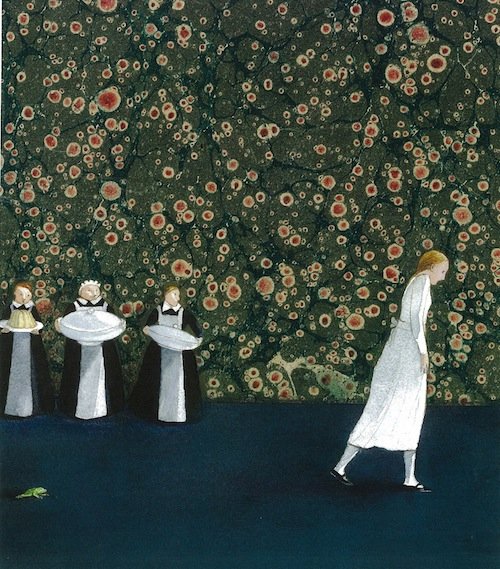
- Didactic literature in human form...AH!
Looking beyond power dynamics and the intricacies of academic dialogue on the nature of didacticism in children’s books, it is necessary to remember that all works of literature, for any age, are acting on some level as teaching tools. This teaching need not be heavy handed, with harsh morals and punishments like that found in evangelical texts for children from the eighteenth and nineteenth centuries. However, lessons are always being passed along through literature. Even as adults we are still learning through fiction, even if it is packaged through the pleasure of the aesthetic presentation, we are still being exposed to different perspectives and broadening our understanding of who we are as individuals and of the world we view through the lens of the novel; with every page we are learning how to be people.
.jpg)

With this in mind, it is essential then that stories for children actually teach them something. However, this teaching does not need to be conventional. It does not need to be didactic and saccharine, in fact if it is, it will fail as a book. Children are indeed some of the toughest and honest critics and to use Deborah Stevenson’s term, a book that fails to entertain, that fails to draw in its readers will not be honored with the “children’s imprimatur” (Stevenson 118). Humphrey Carpenter lays out this idea of the entertainment/morality balance in his essay, between the child’s desire for “adventure and imagination” and the adult’s desire for “moral examples” (Carpenter 1).
However in reading this essay, a statement that followed soon after this balance discussion caught me off guard. Carpenter goes on to say that in order for a text to be successful it must indeed fulfill these two desires, however he says that every once in a while a book comes along which achieves success despite failing to satisfy both parties. He gives Roald Dahl’s Charlie and the Chocolate Factory as his example stating that is “has been loved by children and hated by adults because it is full of fun and virtually amoral” (Carpenter 1). Was I the only one that found this strange? It was even stranger that Carpenter failed to give any support for his statement, leaving it merely as a given that everyone finds Dahl’s novel “amoral”. The first thing that came to mind was, I don’t know of any other book that has so many lessons and morals, some even explicitly spelled out, but in a way that is hilarious and entertaining. Dahl creates the ideal model for children to follow in the character of Charlie, and he then has four characters that exhibit extremes of what children should not be like. One of the most memorable excerpts from the novel is the Oompa-Loompa song directed at parents (if you'd like to hear it sung and watch it performed, it's actually included in the Tim Burton film, check it out here):
"The most important thing we've learned,
So far as children are concerned,
Is never, NEVER, NEVER let
Them near your television set --
Or better still, just don't install
The idiotic thing at all…
did you ever stop to think,
To wonder just exactly what
This does to your beloved tot?
IT ROTS THE SENSE IN THE HEAD!
IT KILLS IMAGINATION DEAD!
IT CLOGS AND CLUTTERS UP THE MIND!
IT MAKES A CHILD SO DULL AND BLIND
HE CAN NO LONGER UNDERSTAND
A FANTASY, A FAIRYLAND!
HIS BRAIN BECOMES AS SOFT AS CHEESE!
HIS POWERS OF THINKING RUST AND FREEZE!
HE CANNOT THINK -- HE ONLY SEES!
What used the darling ones to do?
Have you forgotten? Don't you know?
We'll say it very loud and slow:
THEY ... USED ... TO ... READ! They'd READ and READ,
AND READ and READ, and then proceed
To READ some more. Great Scott! Gadzooks!"
As I continued to think about Dahl’s novel and it’s relation to didacticism/morality and entertainment, I realized in a way, Dahl is doing for children’s books what Flannery O’Connor did for her adult readers. They both utilize the shock factor, they stay clear of heavy-handed didacticism. But they are in no way elevating or suggesting that readers should follow in the footsteps of the many amoral characters that populate the pages of their stories. Instead, they both utilize the grotesque in order to shock their readers and bring a realization of how they as people should act. Moreover the grotesque in a way brings on a sort of grace and salvation. And in Dahl’s case this produced not only for his readers, but also for the amoral children in his story because although they are cruelly punished, they do not perish, they come out alive, but severely altered, ready to start out on a better and more enlightened path, a path which we as readers are able to take without having to actually learn it the hard way.

Works Consulted:
Humphrey Carpenter’s “Secret Gardens”
Deborah Stevenson’s “Classics and Canons”
Roald Dahl’s Charlie and the Chocolate Factory
Jon M. Sweeney's article from American Magazine, “Grace and Grotestque” (http://americamagazine.org/issue/701/ideas/grace-and-grotesque







